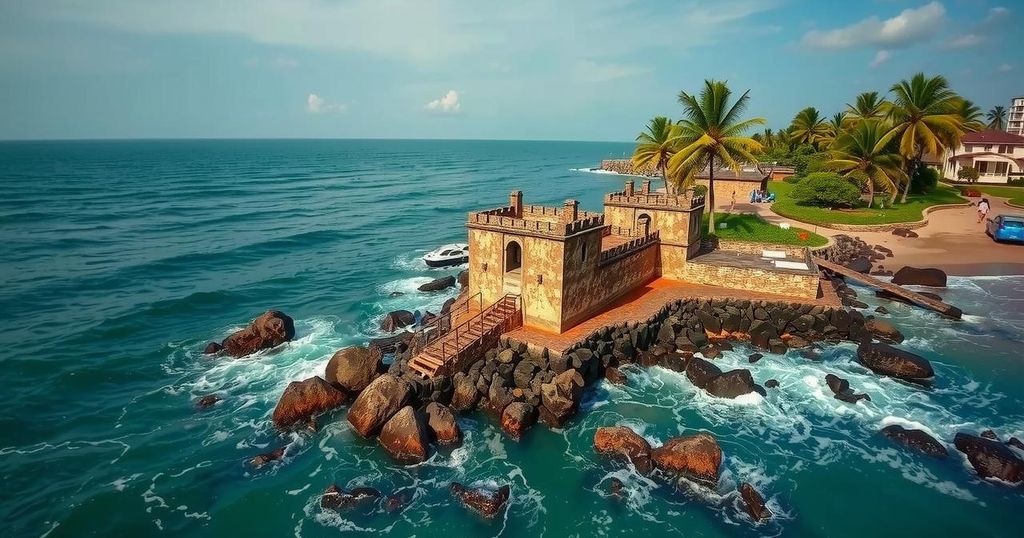Ghana’s Historic Forts at Risk Due to Climate Change

Ghana is losing historic forts along its coastline due to climate change, with severe coastal erosion affecting both cultural heritage and local communities. Protection efforts are in place to address the loss and impact of rising sea levels.
Ghana is currently experiencing significant loss of its historic coastal forts, resulting from intense tidal waves from the Atlantic Ocean. This erosion is part of a broader trend that has led to the gradual disappearance of several coastal communities along Ghana’s 550-kilometer coastline. A study conducted by the Institute for Environment and Sanitation Studies indicates that Ghana suffers an average loss of two meters of coastline annually, with some areas enduring total losses of up to 17 meters. The rise in sea levels, associated with climate change, threatens not only the livelihoods of residents in low-lying regions but also endangers the country’s invaluable historic slave forts and castles. Among the iconic structures at risk is the once-imposing Fort Prinzenstein in Keta, Volta Region, a testament to resilience over its 240 years, yet now ravaged by a decade of destructive tidal forces. James Ocloo Akorli, the fort’s caretaker, reports that approximately two-thirds of it is now submerged beneath the ocean. He states, “Eight of its ten dungeons, originally built to hold enslaved Africans during the trans-Atlantic slave trade, were completely submerged before a sea defense wall was erected to protect what remains of the monument.” In a similar plight, Fort Kongenstein in Ada, Greater Accra Region, has succumbed to relentless waves, leaving no trace of its existence. Also, Fort Fredensborg in Old Ningo, aged 289 years, has drastically diminished, now reduced to a mere remnant. As pointed out by Joyce Ayorkor Guddah, the Tourism and Culture Officer in Ningo Prampram district, “Fort Vernon has become a death trap, as the tidal waves have severely damaged it.” Accompanying the loss of these forts is the dire situation faced by nearby coastal communities, which are threatened by the encroaching sea. Akorli Simon, a former resident of Fuveme, recalls the devastation of his community: “the Sea began swallowing our community. We were devastated and had to abandon Fuveme in 2016 after a powerful tidal surge washed away the land.” After relocating to Dzakplagbe, he now fears a similar fate for his new home. In the Western Region, Anlo village has been reduced to a precarious stretch of land, ensnared between rising tidal waters and the lagoon fed by the River Pra. In Accra’s Glefe suburb, many residents have fled their homes in the wake of destructive tidal incursions. In response to this crisis, efforts are underway to mitigate coastal erosion. One such initiative is the construction of the 8.3-kilometer Keta Sea Defence Wall, a project commenced over a decade ago with financing from the United States Export-Import Bank totaling $94 million. Additionally, the West Africa Coastal Areas Resilience Investment Project, Ghana 2, seeks to enhance the resilience of Ghana’s coastal regions while also protecting vital coastal ecosystems. The Minister of Environment, Science, Technology, and Innovation, Ophelia Mensah Hayford, emphasized the importance of a $155 million project funded by the World Bank. This project is set to be implemented in key vulnerable areas like Korle Lagoon, Densu Basin, and Keta Lagoon, which have historically struggled against tidal waves, flooding, pollution, and erosion.
Ghana’s coastline, which stretches approximately 550 kilometers, is facing immense challenges due to climate change effects, including rising sea levels and increased tidal activity. Historic forts built centuries ago, significant for their cultural and historical importance, are now under threat as coastal erosion forces them beneath the waves. Coastal communities that have thrived for generations now find themselves at risk of extinction as natural forces reshape their environment and living conditions, prompting urgent intervention and restoration efforts to preserve these cultural landmarks and protect the inhabitants of vulnerable coastal regions.
In summary, Ghana’s historic forts are being severely impacted by climate change, with significant portions submerged due to erosion and tidal waves. This situation jeopardizes not only these cultural treasures but also the livelihoods of coastal communities facing displacement. Ongoing protective measures and innovative projects aim to combat the effects of climate change and safeguard both historic sites and vulnerable populations along the coastline.
Original Source: www.rfi.fr







